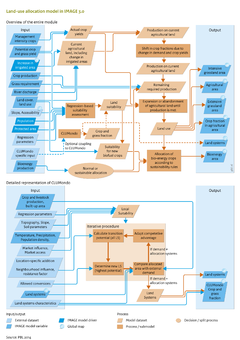Land-use allocation/Policy issues: Difference between revisions
Jump to navigation
Jump to search
m (Text replace - "|Status=On hold" to "") |
No edit summary |
||
| Line 1: | Line 1: | ||
{{ComponentPolicyIssueTemplate | {{ComponentPolicyIssueTemplate | ||
|Description=In a typical baseline scenario, agricultural area increases at the expense of forest land (see for instance [[PBL, 2012]]). The use model can be used to visually indicate where these changes may occur (Figure 4.2.3.2). As such, it can indicate the consequence of expansion of agricultural area in specific loss of ecosystems. | |||
|Example=The policy options that can be analysed are either related to the agricultural economy (see there), or are related to the allocation rules used in the land use allocation module itself. In the study using the OECD Environmental Outlook scenario, for instance, the model was used to evaluate impacts of different protection level of natural areas: i.e. the baseline scenario, an additional 20% (Prot20) of the total area protected or another 50% (Prot50) protected and finally a scenario exploring the impact of protecting of all forestland and woodland) (Ref!). Depending on the type of areas that are protected, the relative reduction in land use and CO2 emissions differs a lot. If forests are protected, almost the same amount of agricultural land is used by switching to non-forested land. Thereby CO2 emissions are reduced, but land use and related biodiversity loss is reduced much less. | |||
}} | }} | ||
Revision as of 12:46, 26 March 2014
Parts of Land-use allocation/Policy issues
| Component is implemented in: |
| Components: |
| Related IMAGE components |
| Projects/Applications |
| Key publications |
